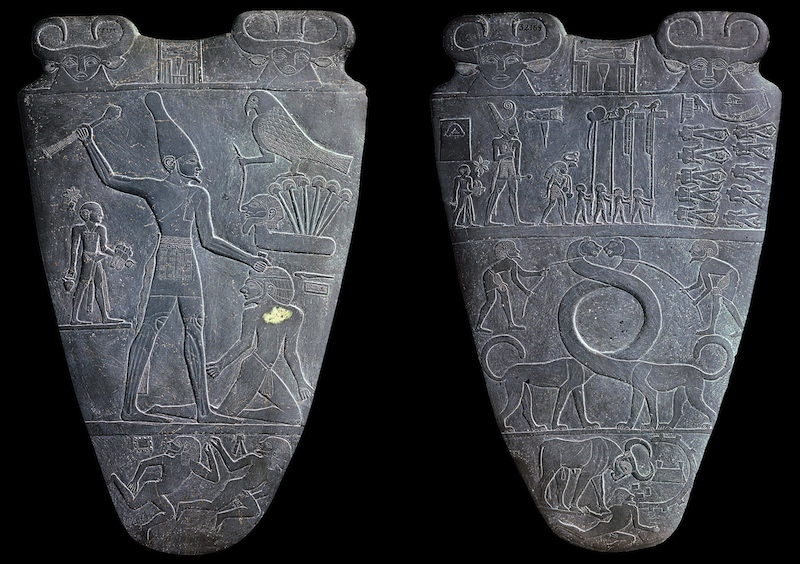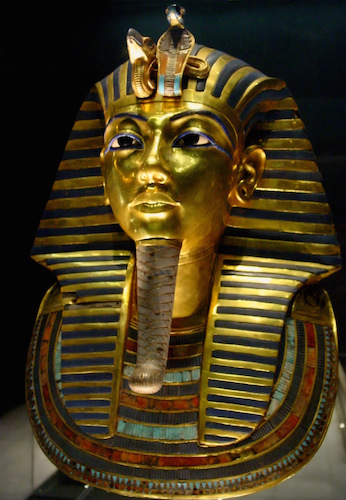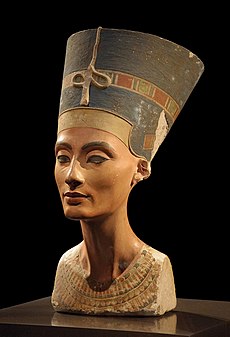Mini-Lecture 2 Art of Egypt
For each period of Art History, I will give a very brief outline of the central ideas, and key artworks found in the chapter. Egyptian art continues to capture our imagination, and has been before us ever since the English discovered the great tombs of ancient Kings.
Egyptian art goes from about 3000 BC to about 650 BC. There are a few key works that I want you to pay attention to:
Palette of King Narmer
https://www.khanacademy.org/humanities/ancient-art-civilizations/egypt-art/predynastic-old-kingdom/a/palette-of-king-narmer

This is an excellent example of Old Kingdom art. Smaller palettes were used to mix make-up to protect the eyes from the sun. This one is a larger version which honors the Pharoah Narmer in his unification of upper and lower Egypt.
Everything is very rigid and formal. The King probably didn’t take part in the battle, and many of the beasts portrayed are mythical. There are strict rules that the artist must follow in representing the holy ruler. One of these rules is termed the rule of frontality. People may be viewed only from the front or side.
If you look at Narmer, his chest faces you while his legs are seen from the side. These rules tell the viewer that this is a symbolic event, a special sacred event set apart from the reality of everyday sight.
Seated Scribe

This middle kingdom figure is a departure from old kingdom artworks. Look at the realism in the abdomen. There we see a realistic portrayal of a middle aged man. Also, some features on the face are extremely true to life. The man seems to be in a trance, and may have been writing in the Book of the Dead. These scribes were accountants for the Pharoah’s state, but also were priests transcribing holy texts.
It explains that when a subject’s importance decreases, the subject is portrayed with more realism.
Death mask of Tutankhamen

This is one of the many objects found by an English archaeologist in Egypt. Tut was made the Pharoah at the age of nine. In the New Kingdom, we will see a new realism flourish. The face is relaxed, and his features may be extremely true to life.
The gold , with precious inlaid stones demonstrate the Egyptian complete mastery of working with the materials. The need of society to create things of beauty, will be seen in diverse peoples from the caves to the great works of the renaissance.
Bust of Nefertiti

Before moving on, take notice of this beautiful bust of this very powerful figure in Egyptian history. She was a queen, married to the king Akhenaton. Together they went against the established religion of the time. The priests were especially afraid of her power.
Like a fashion model, her name translates, “the beautiful one is here”. Her head may be in the shape of a flower on a stalk. The lotus blossom is an example of a flower that symbolized eternal life.
Candela Citations
- Module 2 Egypt and Mesopotamia Mini Lecture Egyptian Art. Authored by: J. Bruce Schwabach. Provided by: Herkimer College. Located at: https://herkimer.open.suny.edu/webapps/blackboard/execute/content/blankPage?cmd=view&content_id=_18185_1&course_id=_953_1. Project: Art History I Achieving the Dream Course. License: CC BY: Attribution